Abstract
Art traditions reflect beliefs, practices, customs and unconscious values. If it is relatively easy to study these features in historic art traditions, the same is not true for prehistoric times. In this case, archaeology has to rely on multidisciplinary approaches in order to counterbalance the deficiencies in documentation. The large quantity of images known to us from the Upper Paleolithic permits a quantitative study of different iconographic features and their change through time. With the program SPSS, I created a database of more than 2,000 images belonging to Upper Paleolithic parietal art, allowing me to study correlations among different discrete variables that open the possibility for finding specific cultural “markers.” This represents an alternative to the study of stylistic features, a qualitative and valid methodology that is sometimes criticized for its lack of objectivity. In this paper, I will discuss the change through time in the preferential profile orientation of figures/images in order to confirm or question the cultural boundaries in Upper Paleolithic Europe.
Introduction
The aim of the present contribution is to study parietal art with the help of descriptive statistics in order to shed light on the chrono-cultural boundaries in Upper Paleolithic Europe. In my PhD thesis (Scardovelli 2017) I developed a methodology joining together archaeological research, statistical analyses and a semiotic approach inspired by embodied cognition theories. The statistical analyses, tables and graphs were developed from a database created with the program SPSS and containing more than 2,000 images from six major painted caves (Lascaux, Chauvet, Rouffignac, Cosquer, Niaux, Pech-Merle) in addition to 24 minor caves containing less than 40 images each (see Table 1). The timespan under consideration extends from the Aurignacian to the Magdalenian (broadly, ~40,000 BP to ~12,000 BP), and all the caves are from central/southern France and the Cantabrian region in Spain. Table 1 indicates the exact number of images recorded for each cave divided into the four chrono-cultural units of the European Upper Paleolithic (Aurignacian, Gravettian, Solutrean, Magdalenian). Each chrono-cultural group is especially associated with one or two cave(s): most of the figures (~90%) from the Aurignacian period are found at Chauvet, while the Gravettian is represented mostly by the Quercy caves (Pech-Merle, Cougnac, ~50 and ~15%, respectively). Lascaux (~80%) and Cosquer (~17%) exemplify the Solutrean (for a discussion on the Solutrean attribution of Lascaux, see Scardovelli 2017: Sect. 3.4.2). The Magdalenian is mainly represented by Rouffignac (~60%) and Niaux (~27%). The existence of largely decorated caves especially associated with particular chrono-cultural groups will be addressed in the hypothesis.
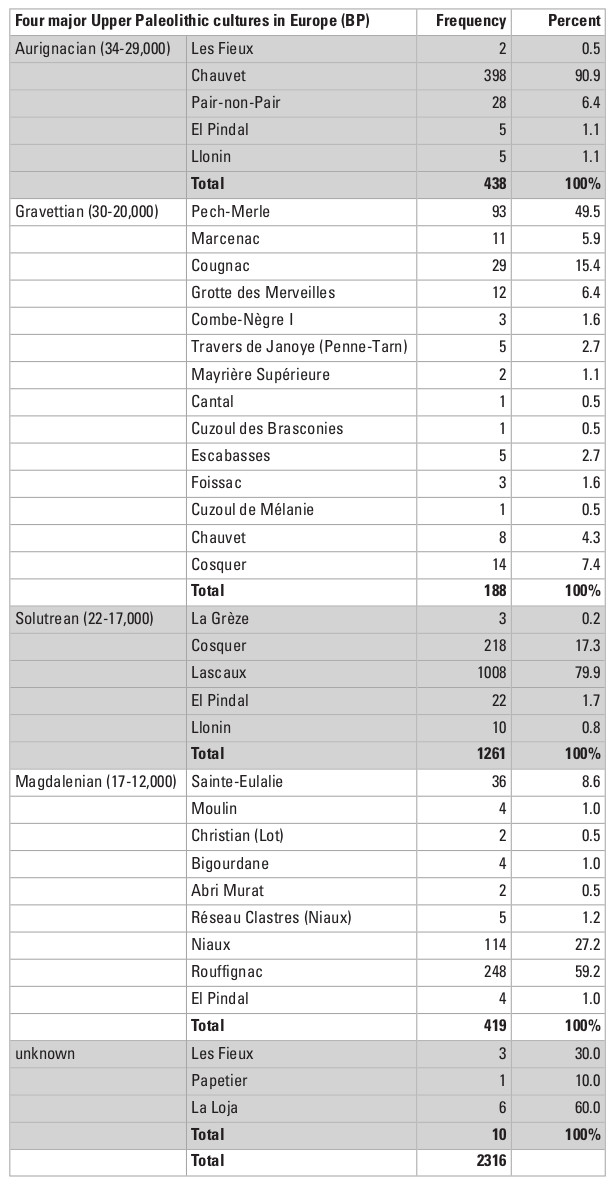
Among the different features that can be analyzed statistically, I chose to consider the orientation of animal figures, that is, the direction, left or right, that the represented animal is facing in relation to the observer (for an example, see Fig. 1). The choice of this topic is based on the assumption that it is possible to draw general conclusions by analyzing if some groups of images show preferential left or right profile (for similar studies in art history, see Chateau 1965; Darras 1996: Chap. 12; Guillaumin 1961; Hinz 1974; Simounet 1975; Zazzo 1950; McManus and Humphrey 1973; Uhrbrock 1973; Sauvet 2005; Barrière 1997: 518). In this text, I investigate an important iconographic change in figure orientation through the Upper Paleolithic in Europe. I will present the quantitative analysis and I will provide a possible interpretation of this shift in profile choice. I would like to clarify that the two things are separated: the statistical demonstration that a significant change has occurred in profile preference during Upper Paleolithic parietal art is one thing; the interpretation of this shift is another thing. If the first data can be considered as hardly questionable, the second one, belonging to the sphere of human interpretation, can always be debated and improved, as is true for any interpretation in any field of study.
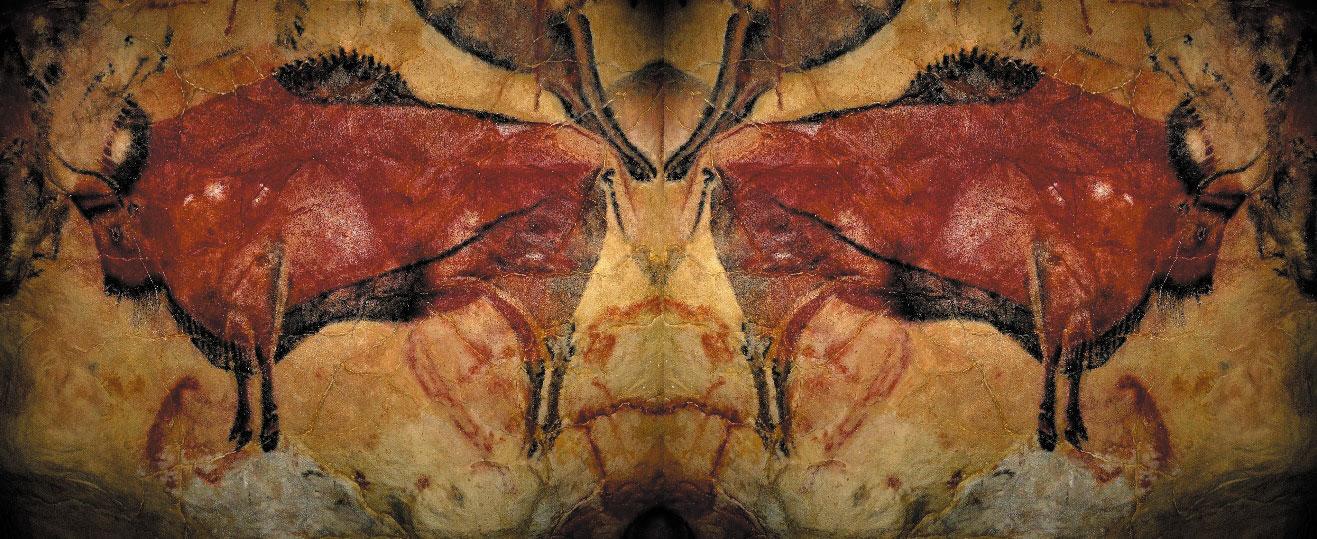
I will now present the data concerning the orientation of the parietal art figures belonging to the database I created. Among the 2,316 figures present in this database, only 1,991 have a known or clear orientation (some figures are partially destroyed and unreadable, for others there is no profile, such as for figures facing the observer, and for a third group it was not possible to collect such information). In total, 1,033 of 1,991 figures show a preference for left orientation, representing the ~52 % of the total.
What is particularly interesting for determining chrono-cultural boundaries in Upper Paleolithic Europe is the diachronic change of this preference among the Aurignacian, the Gravettian, the Solutrean and the Magdalenian. In fact, as we can see in Figure 2, there has been a significant shift from left to right profile preference from the Aurignacian period to the following ones. At a descriptive level, the same trend seems to persist irrespective of the caves considered: in Figure 3 we can see that the Aurignacian is dominated by left-facing figures, as seen in Chauvet or other minor sites. The Gravettian and the Solutrean reveal more balanced results, with the only exception being the Quercy caves (Pech-Merle and Cougnac). Finally, the Magdalenian presents a large number of right-facing figures, with the only exception being some minor caves. In sum, we seem to be acknowledging a major shift in some aesthetic value of images in the passage from the Aurignacian to later periods. For correctly interpreting such a result, it is imperative to take a step back and consider the studies concerning figure orientation in general.
Contextualizing the research: The study of figure orientation in art history
Several researchers (see above section) have tried to analyze different art traditions in the light of figure orientation, even if a global vision on this topic is still lacking. Broadly, it is possible to affirm that four kinds of influences, apart from chance, determine the orientation of a figure, and they can be labeled as follows: cultural, bio-mechanical, contextual and neurological. Their mutual interaction is debatable; therefore, it is preferable to study each influence individually. In this brief review, I will assume that the creator of images is a right-handed individual, and this for two main reasons: first, because humans have been preferentially right-handed for many millennia (Cashmore, Uomini, and Chapelain 2008; Frayer et al. 2012; Toth 1985); second, because some interesting observations seem to suggest that European paleo-artists were effectively right-handed (Groenen 1997).
The first sort of influence is cultural, and based on any sort of graphic convention. The more common cultural influence is the script habit of writing from left to right or from right to left, something that can strongly influence image profile orientation (Tosun and Vaid 2014). For Westerners who write from left to right, it is more natural to draw animals oriented to the left. During the Paleolithic there was no writing system; nonetheless, some cultural code related to figure orientation cannot be discounted (Sauvet 2005). But it is not my intention to take this kind of influence into account here, not least due to a clear lack of knowledge in this regard.
The second group of factors concerns the so-called “bio-mechanical” constraints. Some experts think that, for right-handers, the movement of the arm from left to right is more “natural” than the opposite movement (Van Sommers 1984: 91). As a consequence, there would be a generic preference for left-facing figures. According to the theory, this factor is strongly hard-wired, somehow applying to all artistic traditions. Whether this theory is valid or not, it is of no interest for us, since we are looking for diachronic transformation revealing cultural boundaries: bodily “universals” are not a good starting point here.

I call the third group of factors “contextual.” I provide below some examples in order to show how studies conducted in the present time can predict some peculiarity of parietal art. In some cases, the orientation of a figure is determined by factors that go beyond the single image. One example is when an artist creates a composition, for example the scene of the Nativity in a Christian context. In a classic Nativity scene, all people in the painting look towards the newborn Jesus, so their place in the composition determines the direction of the face. Scenes are rare in Paleolithic art, and the difficulties in interpreting such scenes make the study of this factor highly complicated.
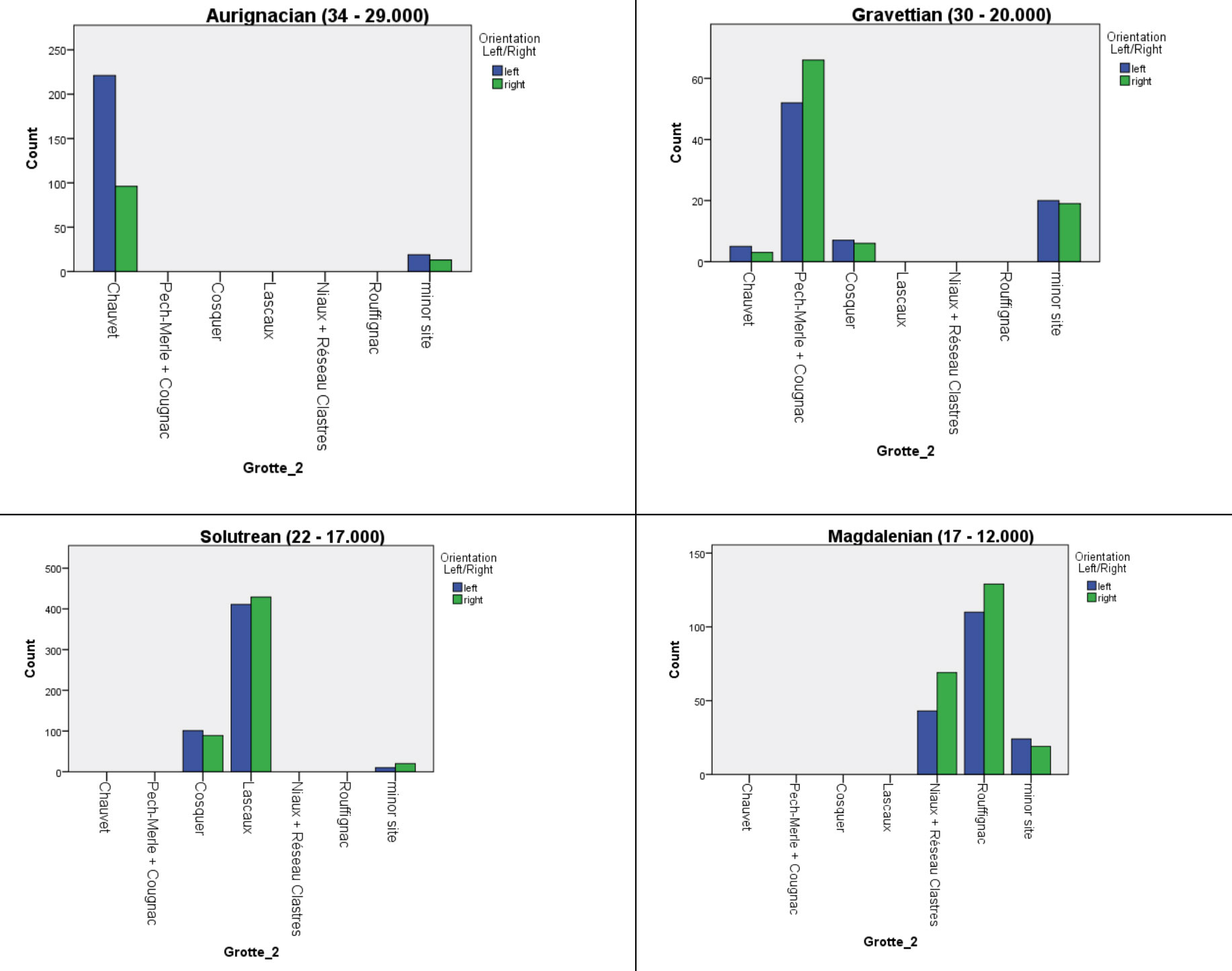
Another case, always falling into the general sphere of “contextual” factors, is the effect of the visual disturbance of our hand and arm during the act of drawing (Braswell and Rosengren 2000: 154; Simounet 1975: 49). When creating small figures, right-handed people might have their view obscured by their drawing hand. Thus, there is a natural tendency to draw small figures oriented to the left in order to see the figure most of the time during its realization. This factor may concern parietal art in a special way, since illumination in caves at that time was scarce. In fact, it is true that small images are oriented to the left more often than larger images (see Fig. 4) The significant relation between these two variables is also statistically validated (see graphic’s legend). The trend seems to remain unchanged during the entire Upper Paleolithic (Fig. 5). But this time the statistical significance remains valid only for one chrono-cultural unit, i.e., the Solutrean, reflecting the fact that only Lascaux has a significant relation to the variable of profile orientation (Chi2(2) = 10,370, p = 0.006). Despite the fact that only Lascaux shows a statistical significance for our purposes here, if we merely look at percentages, all caves show the same trend of leftward-facing small figures and rightward-facing larger figures (data not shown), with the only exception being the small caves considered altogether (but this might be simply a consequence of a lack of data, since in this category I only counted 122 figures). If the topic of this study was the phenomenon described in the present paragraph, I might of course deepen the statistical investigation. But the shift of orientation in respect to the dimension of the image is not my concern here; my goal is only to show how present-day studies can be used for interpreting some minor characteristics of parietal art.

The fourth and last group of factors can be labeled as “neurological,” and relate to brain hemispheric asymmetries (for a review, see Scardovelli 2017: Sec. 8.1). Before continuing, it is important to clarify something: the neurological aspects that I will consider have been studied in “passive” situations, when subjects were feeling something or looking at something. Nonetheless, it is possible to imply that the neurological aspects discussed below are analogous to the ones implied in “active” situations, such as during the act of drawing. As I have discussed in Scardovelli (2017: Sec. 8.1), following research of embodied cognition, the neurological processes involved in perception are often analogous to the neurological processes operating during action and ideation (for a general discussion on the topic of embodied cognition, see Barsalou 2008).
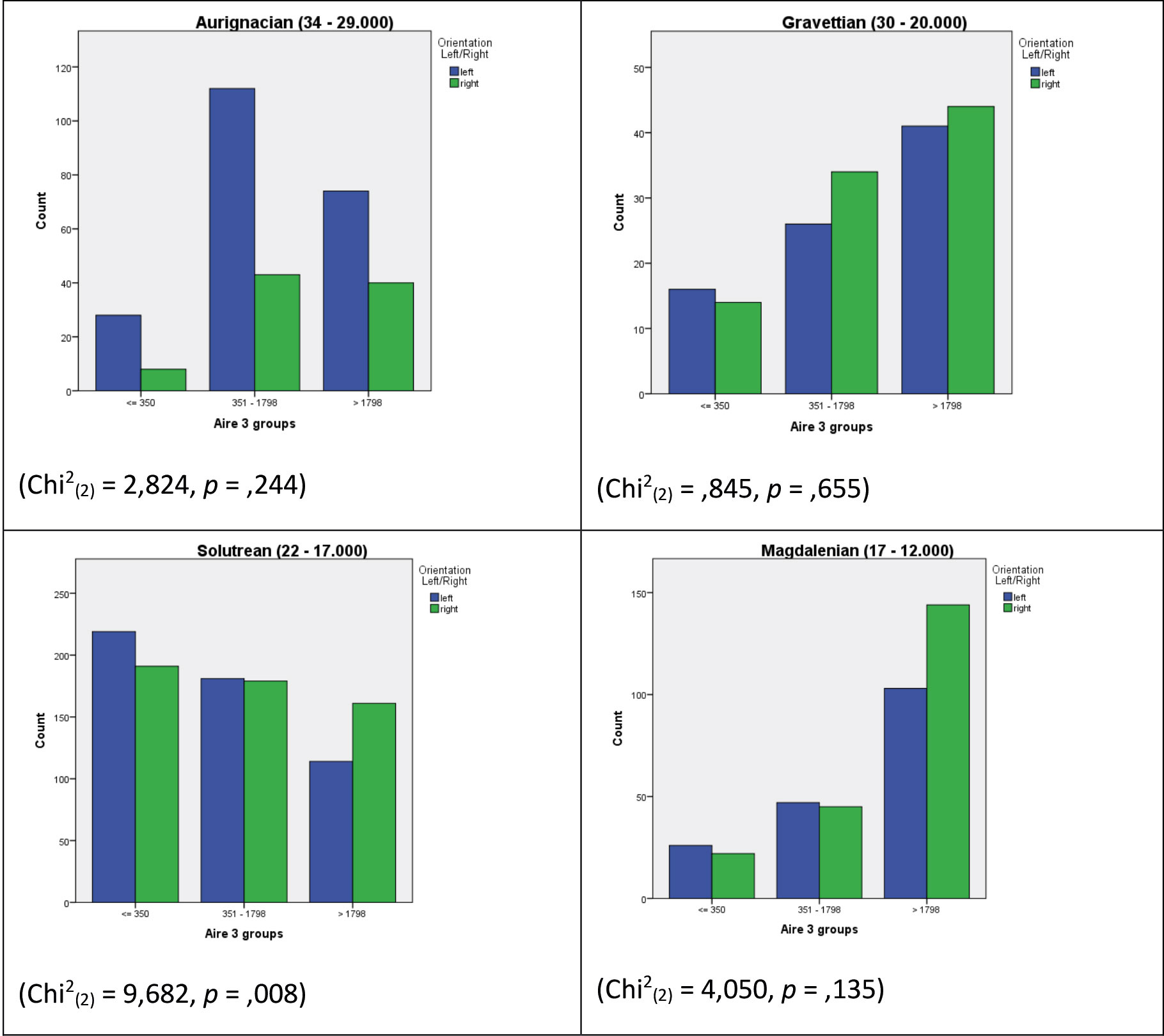
The two hemispheres differ in several characteristics, but here I will discuss only two aspects in particular: the first one is the Face Perception Module, that is more commonly located in the right hemisphere (Gazzaniga and Smylie 1983). This determines facilitation, for our neurological system, in visualizing faces located in the left side of our visual field, and therefore faces looking left. This factor too can be detected in prehistoric art: representations of animal heads (without the body) show a significant preference for left orientation (see Fig. 6). The trend seems to remain unchanged throughout the entire Upper Paleolithic (Fig. 2). But, as was the case for the study of profile preference in relation to the dimensions of figures, here as well the trend is corroborated only by simple percentages and not by statistical significance, again with the only exception being the Solutrean period, dominated by Lascaux. The results concerning the Aurignacian and the Gravettian show a trend towards statistically significant results. The same trend, in mere percentage terms, can also be observed among single caves, with the only exception being Rouffignac (data of caves not shown).
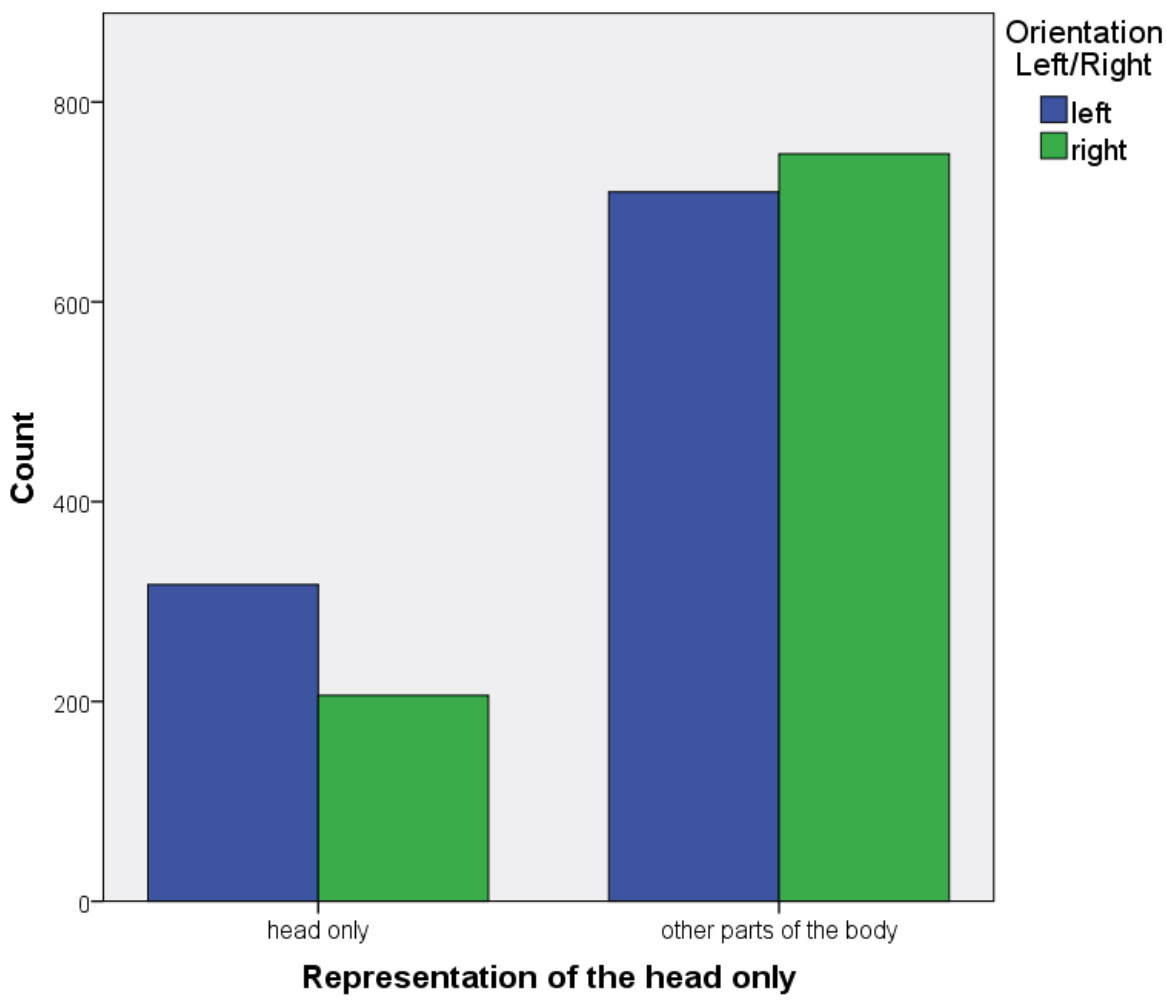
The second neurological factor that I consider here, which will be the focus of my interpretation further in this article, relates to the treatment of effects and emotional states in the two hemispheres. In general, we know that the RH (Right Hemisphere) is more concerned with any kind of emotional arousal if compared with the LH (Left Hemisphere), which is specialized in other kinds of contents, such as planned actions or linguistic messages (for a general discussion, see Scardovelli 2017: Sec. 6.3). According to more subtle investigations, researchers could determine that the LH is concerned in particular with the spectrum of “positive” affects (pleasure, appreciation, desire), while “negative” affects (fear, depression, aversion) are more clearly associated with the RH (Powell and Schirillo 2009). In fact, researchers found that, in some art traditions, figures show a preferential orientation determined by the relationship—positive or negative—that the artists have with the subjects represented in the painting. Humphrey and McManus (1973), for example, analyzed 335 portraits created by Rembrandt. The persons portrayed have been divided into 5 categories: “female non-kin,” “female kin,” “male non-kin,” “male kin,” and “self-portraits.” The authors noticed that if the subject represented was a stranger or a woman, it tended to face left. On the contrary, self-portraits tended to be right facing. In conclusion, the authors suggest that subjects facing left seem to reveal negative and aversive emotions, and subjects facing right seem to be linked with positive emotions.
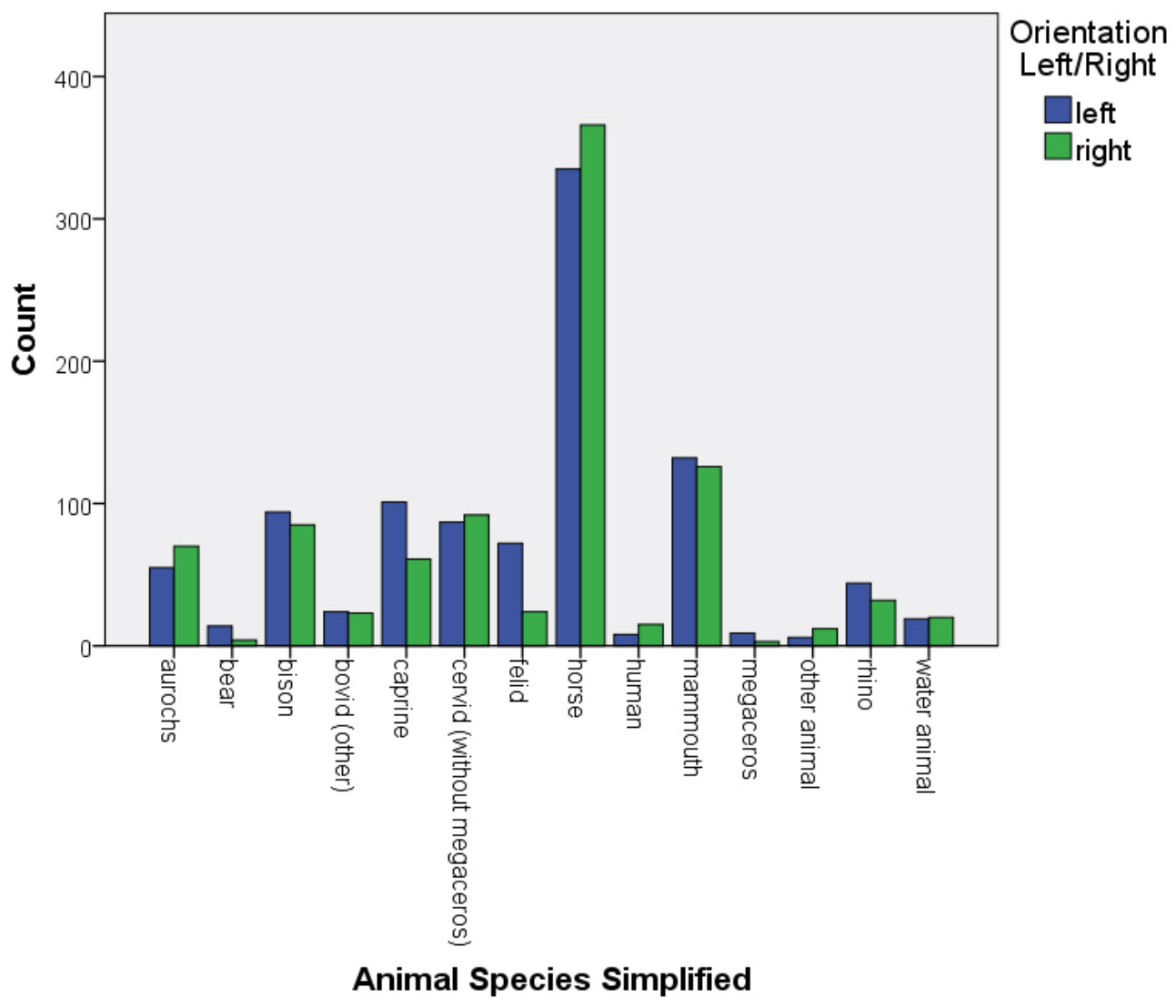
Their conclusion is that the social distance from the artist determines an unconscious preference for left profile, associated with “social distance” and “negative effect,” while the right profile is associated with “social proximity” and “positive effect.” These authors do not associate this result with cerebral asymmetry. Nevertheless, other results based on laboratory studies openly associate better performances with left visual field and negative emotions, and right visual field with positive emotions (Jansari, Tranel, and Adolphs 2000; Powell and Schirillo 2009: 554–56; Reuter-Lorenz and Davidson 1981). But how does neural specialization (i.e., the hemispheric specialization for the treatment of effects), which has been studied in passive conditions, become responsible for an artistic creation? As I stated at the beginning of this section, following the insights of so-called “embodied cognition,” it is possible to postulate analogous neurological mechanisms at work during passive and active situations. Thus, assuming that scenes and figures associated with negative effects are decoded and processed faster if located in the left visual field, it is possible to postulate that artists too will have a tendency to represent negative effects in the left hemifield and/or through a figure facing left (for a discussion, see Scardovelli 2017: Sec. 8.1). This is exactly what has been discovered in the study of Rembrandt’s drawings. As anticipated, this factor will be the only one examined later in this article.
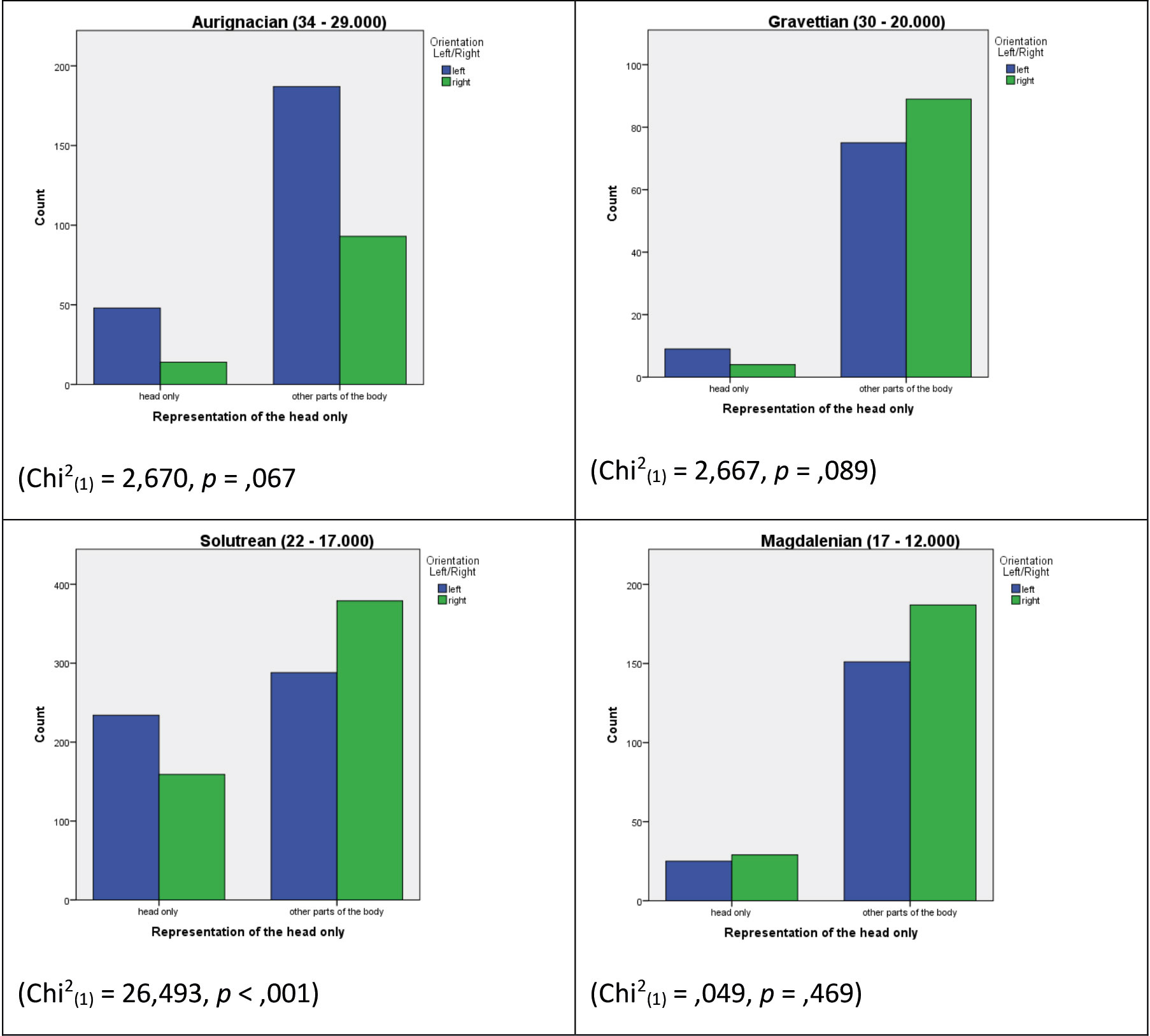
Profile preference and animal species
Statistical analyses permit us to go further in the study of orientation preferences in European parietal art. One of the most interesting studies that can be done concerns the variation of profile orientation among the different animal species represented on the cave walls (see Figs. 7-8).
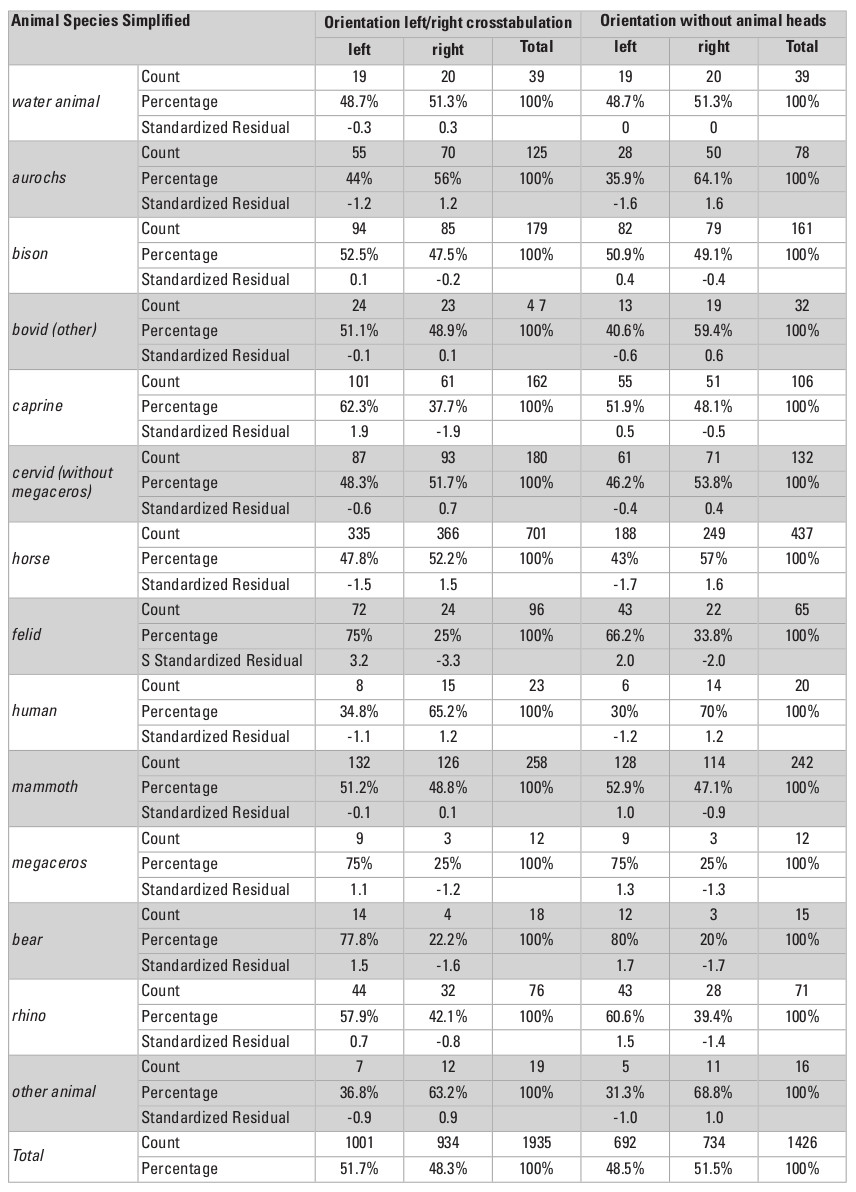
Since a graphic is not sufficient for appreciating the statistical significance of the results, it is better to complete it with a crosstab, where the “Standardized Residual” allows us to appreciate how a certain frequency has to be considered significantly different from the expected result if data were distributed by chance. Standardized residuals that are greater than 2 mean that a specific result is significantly higher than the expected result, and those smaller than -2 mean that a result is significantly lower than the expected result. In Table 2 we can thus confirm that some animal species have a significant preferential orientation. Considering the animals showing a preferential left orientation, in the first stance felines show a statistically significant left orientation (standardized residual = 3.2). The second interesting category of data comes from the caprines, showing a particular preference for left orientation as well. In this case, I don’t think that the outcome really deserves further attention, since this result seems to be uniquely related to the large number of figures of caprine heads that, as we have seen are preferentially represented in left profile due to mere neurological reasons. In fact, if we look at the right side of Table 2, where I considered all figures with the exception of heads only, we can see that the results remain almost the same for each animal category, with the only exception being caprines, which in this case do not have a preferential orientation. The third animal associated with preference for left profile is bear, which is oriented left 77% of the times (standardized residual = 1.5). In contrast, the animal categories showing a preference for right orientation include horses (standardized residual = 1.5) and humans (1.2).
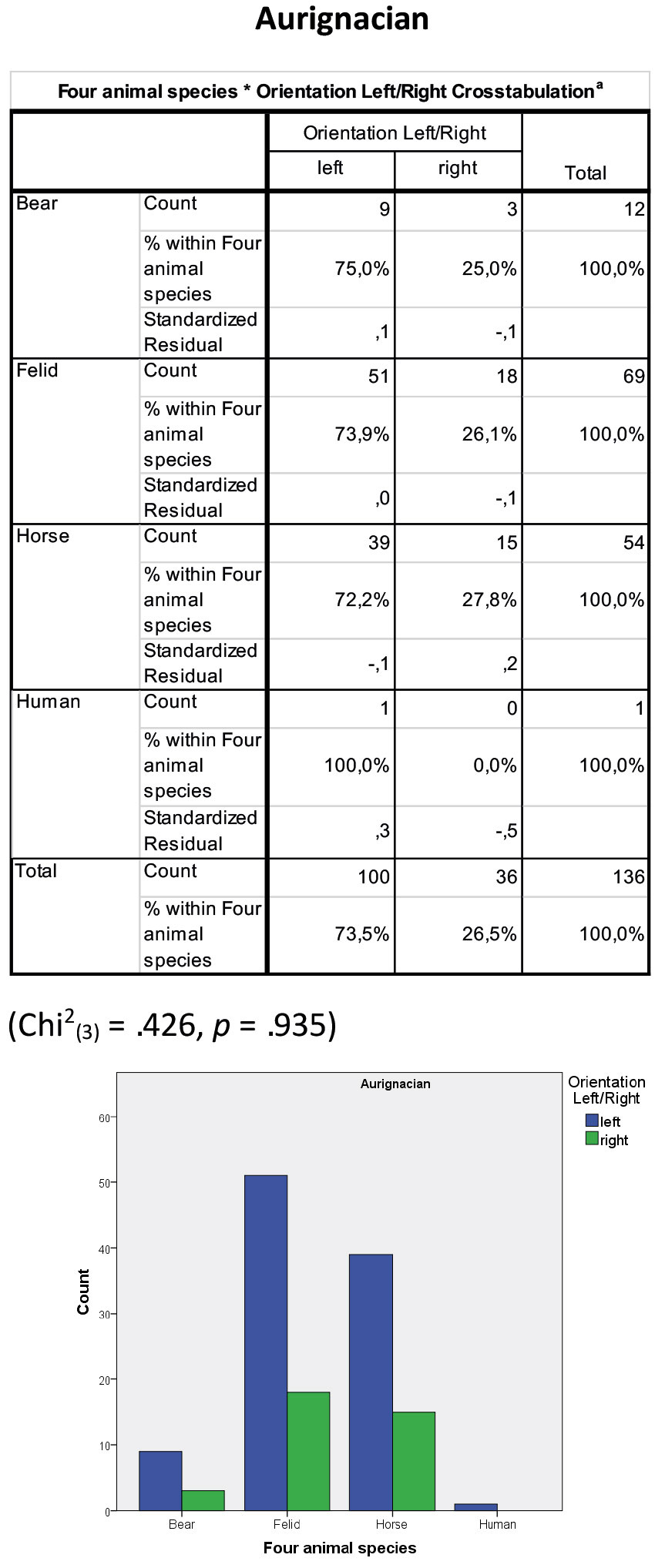
It is quite interesting to note that in the category of the left-oriented figures we find preferentially felines and bears, i.e., two predators (bears do not hunt all the time, being omnivores, but nonetheless they do hunt). Felines in particular represent a peculiar category in Upper Paleolithic visual imaginary, a topic that has been investigated since the beginning of the research on Paleolithic art (for reviews, see Fritz et al. 2011; Rousseau 1967). It is necessary to go back to what I said in the first section, when I quoted some studies suggesting that left profiles might be associated with some sort of negative effect, and right profiles with positive ones. In fact, it is possible that a preference for the left profile in felines might reflect a deep emotional connotation related with negative effects (for further details, see Scardovelli 2017: Chap. 8).
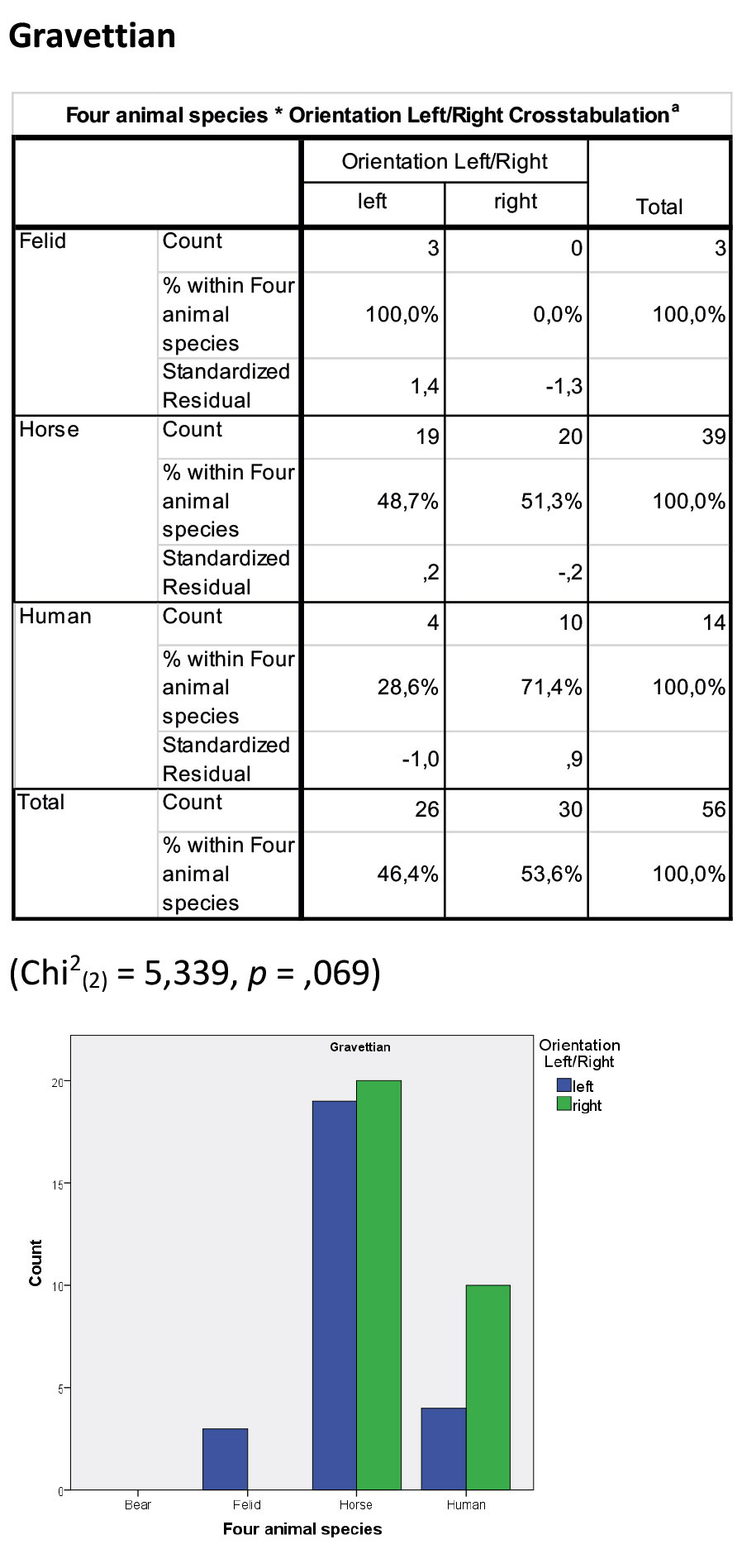
It is in fact astonishing that the only two terrestrial predators present in Paleolithic bestiary share the same preference for left profiles. On the other hand, we find horses and humans sharing a preference for right orientation. The bond connecting these two “animals” is less clear. Yet, ethologically speaking, they can both be considered as unique among Paleolithic bestiary. First of all, we can consider humans as “special,” if not by definition, at least for the special treatment that human figures have received in Paleolithic art (Gaussen 1993). And if we have to find what distinguishes horses from the rest of Paleolithic bestiary, it is the only large herbivore present in Upper Paleolithic Europe without defensive means, such as horns, antlers, tusks, etc. Their specialization when facing danger is their velocity for running away. It is possible that this fact could have played a role in the construction of Paleolithic bestiary, revealing an interest in animal anatomy, horns, antlers, etc. But in conclusion, it is more reasonable to say that this second category, regarding humans and horses, is less clearly delineated than the first one. It is, however, interesting to consider that a similar dichotomy in orientation is found in the research of Le Quellec (1998) on the Neolithic North African engravings of the Lybian Messak. The corpus of images reveals 10,000 units, and the figures on average are oriented to the right 71.9% of the time. In Le Quellec’s table on page 322, equids are second (after ostriches) in right-facing species (79%), and the felids are second (after ovines) in left-facing species (63%), in relative and not absolute terms. This of course is not proof of anything, but still the parallelism deserves to be mentioned, also when we consider the large quantity of images studied by Le Quellec.
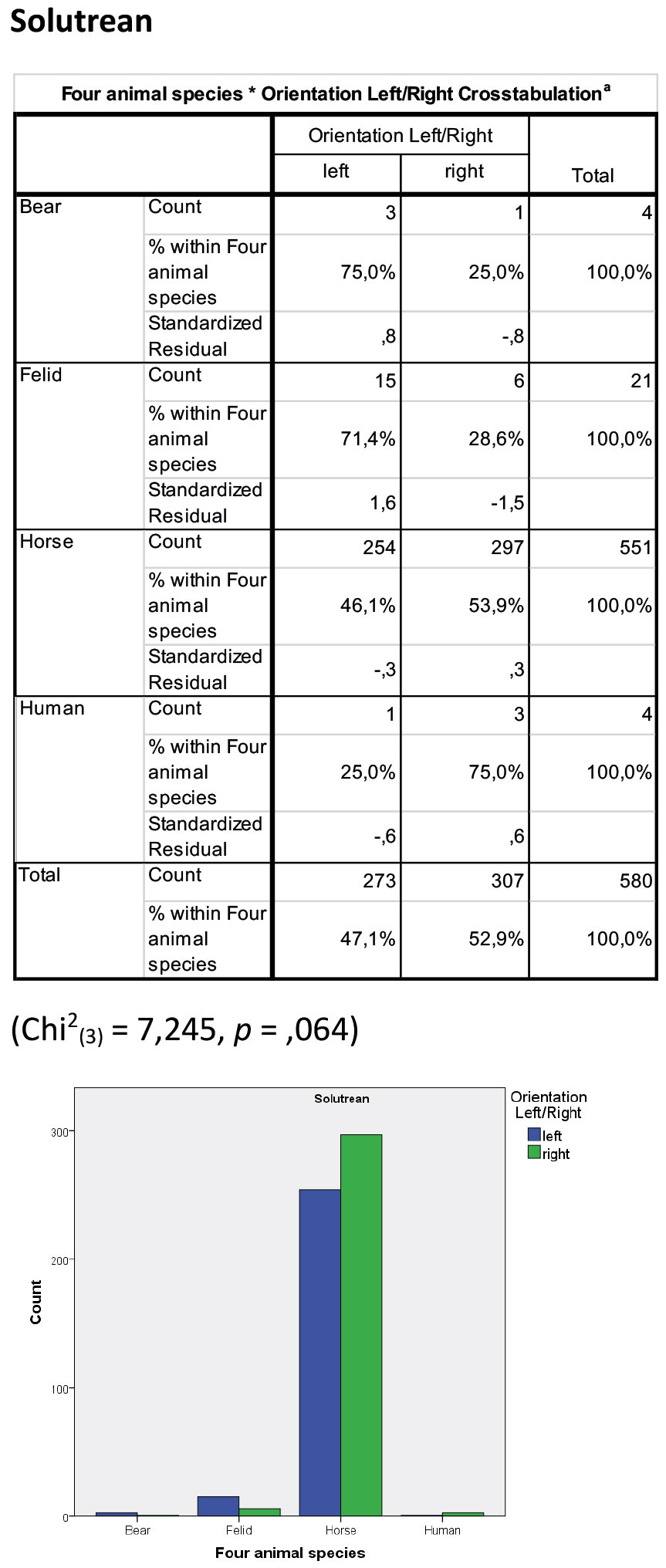
Figure 9a-c (divided into three parts across the following pages) shows how the preferential profile of these four animal species (bears, felids, humans and horses) changed over time. In fact, we already noticed (Fig. 2) that during the Aurignacian all animal species reveal a preference for the left profile (Fig. 3 showed that this trend is valid for Chauvet as well as for minor sites). The real shift occurred between the Aurignacian and the following periods, when we see the appearance of a sort of dichotomy. On the one hand, we find felids revealing a clear preference for the left profile (the statistical tests show a trend towards statistically significant results; data are in the table) followed by bears (whose numbers are too scarce for having any statistical significance). On the other hand, we find the other two animal categories (humans and horse) revealing a slight preference for the right profile, or no preference at all. Felids are the only category revealing a difference in statistical terms. In other words, during the Aurignacian, in all the caves that I recorded, all animal figures present a global preference for the left profile. From the Gravettian on, felids in particular maintain this preference, while the rest of the bestiary shift either to no real preference for a particular profile, with a slight preference for the right profile (horses and humans).
The information presented above provides the primary results of this study. We saw that in the passage from the Aurignacian to later periods a major shift occurs in some aesthetic value of images. What is astonishing is the stability of exactly the same trend beginning in the Gravettian, as if the Upper Paleolithic in Europe was divided, from the point of view of figure orientation and of artistic expression, in two major periods: the Aurignacian and all later periods. From a broader perspective, it is also interesting that Aurignacian artistic expression in general is characterized by a wide use of ivory-carving in realizing three-dimensional statuettes, while during the following periods, preferences in mobile art become the engravings on portable objects.
In conclusion, in this paper I examined the statistical distribution of left- and right-facing animal figures in the parietal art of the Upper Paleolithic. I noticed a major shift of profile preference between the Aurignacian and subsequent periods. This shift is so significant that, on a first level of interpretation, it seems to give credit to those models interpreting the passage from the Aurignacian to the Gravettian as a saltation scenario, as for example, in the context of a population replacement, and not as a slow cultural transformation (Otte 2011). More subtle analyses also seem to suggest that a strong dichotomy emerged starting with the Gravettian, a dichotomy that sees “dangerous” left-facing animals on one side (namely, felids and bears), and “non-dangerous” right-facing animals on the other (horses and humans). Further analyses are required to confirm or reject this hypothesis.
References
Barrière, C. 1997. L’art pariétal des Grottes Des Combarelles. Paléo 1: 1–607.
Braswell, G. S., and K. K. Rosengren. 2000. Decreasing variability in the development of graphic production. International Journal of Behavioral Development 24 (2): 153–66.
Cashmore, L., N. T. Uomini, and A. Chapelain. 2008. The evolution of handedness in humans and great apes: A review and current issues. Journal of Anthropological Sciences = Rivista Di Antropologia: JASS 86: 7–35.
Chateau, J. 1965. Attitudes intellectuelles et spatiales dans le dessin. Paris: Centre national de la recherche scientifique.
Darras, B. 1996. Au commencement était l’image: Du dessin de l’enfant à la communication de l’adulte. Paris: ESF.
Fagard, J. 2004. Droitiers/Gauchers: Des asymétries dans tous les sens. Bruxelles: Groupe de Boeck.
Frayer, D. W., C. Lalueza-Fox, and L. Bondioli. 2010. Right handed Neandertals: Vindija and beyond. Journal of Anthropological Sciences 88: 113–27.
Frayer, D. W., M. Lozano, J. M. Bermúdez de Castro, E. Carbonell, J. L. Arsuaga, J. Radovčić, I. Fiore, and L. Bondioli. 2012. More than 500,000 years of right-handedness in Europe. Laterality: Asymmetries of Body, Brain and Cognition 17 (1): 51–69.
Fritz, C., P. Fosse, G. Tosello, G. Sauvet, and M. Azéma. 2011. Ours et lion: Réflexion sur la place des carnivores dans l’art Paléolithique. In ResearchGate, ed. by J.-P. Brugal, A. Gardeisen, and A. Zucker, pp. 299–318. Antibes: Éditions APDCA.
Gazzaniga, M. S., and C. S. Smylie. 1983. Facial recognition and brain asymmetries: Clues to underlying mechanisms. Annals of Neurology 13 (5): 536–40.
Groenen, M. 1997. La lateralizzazione nelle representazioni di mani negative Paleolitiche/La latéralisation dans les représentations des mains négatives Paléolithiques. Manovre 14: 31–59.
Guillaumin, J. 1961. Quelques faits et quelques réflexions à propos de l’orientation des profils humains dans les dessins d’enfants. Enfance 14 (1): 57–75.
Hinz, Berthold. 1974. Studien zur Geschichte des Ehepaarbildnisses. Marburger Jahrbuch Für Kunstwissenschaft 19: 139–218.
Humphrey, N. K., and I. C. McManus. 1973. Status and the left cheek. New Scientist 59: 437–39.
Jansari, A., D. Tranel, and R. Adolphs. 2000. A valence-specific lateral bias for discriminating emotional facial expressions in free field. Cognition and Emotion 3 (14): 341–53.
Le Quellec, J.-L. 1998. Art rupestre et préhistoire du Sahara. Paris: Payot. McManus, I. C., and N. K. Humphrey. 1973. Turning the left cheek. Nature 243 (5405): 271–72.
Otte, M. 2011. La Gravettien, considéré en 2010. In À la recherche des identités Gravettiennes: Actualités, questionnements et perspectives (Actes de la table ronde sur le Gravettien en France et dans les pays limitrophes. Aix-En-Provence, 6-8. X. 2008), by N. Goutas, L. Klaric, D. Pesesse, and P. Guillermain. Mémoire LII. Joué-Lès-Tours: Société Préhistorique Française.
Powell, W. R., and J. A. Schirillo. 2009. Asymmetrical facial expressions in portraits and hemispheric laterality: A literature review. Laterality 14 (6): 545–72. https://doi.org/10.1080/13576500802680336.
Reuter-Lorenz, P., and R. J. Davidson. 1981. Differential contributions of the two cerebral hemispheres to the perception of happy and sad faces. Neuropsychologia 19 (4): 609–13. https://doi.org/10.1016/0028-3932(81)90030-0.
Rousseau, M. 1967. Les grands félins dans l’art de notre préhistoire. Paris: Éditions A. & J. Picard et Cie.
Sauvet, G. 2005. La Latéralisation Des Figures Animales Dans Les Arts Rupestres: Un Exemple de Toposensitivité. Munibe. Antropologia-Arkeologia 57: 79–93.
Scardovelli, M. W. 2017. Étude sémiotique sur la latéralisation des figures animales dans l’art pariétal du Paléolithique En France. Montréal, Québec (Canada): Université du Québec à Montréal.
Simounet, C. 1975. La droite et la gauche dans le dessin de l’enfant et de l’adulte. Enfance 28 (1): 47–69.
Tosun, S., and J. Vaid. 2014. What affects facing direction in human facial profile drawing? A meta-analytic inquiry. Perception Abstract 43 (12): 1377–92.
Toth, N. 1985. Archaeological evidence for preferential right-handedness in the Lower and Middle Pleistocene, and its possible implications. Journal of Human Evolution 14 (6): 607–14.
Uhrbrock, R. S. 1973. Laterality in art. The Journal of Aesthetics and Art Criticism 32 (1): 27–35. https://doi.org/10.2307/428700.
Uomini, N. T. 2009. The prehistory of handedness: Archaeological data and comparative ethology. Journal of Human Evolution 57 (4): 411–19.
Van Sommers, P. 1984. Drawing and cognition: Descriptive and experimental studies of graphic production processes. New York: Cambridge University Press.
Zazzo, R. 1950. Le geste graphique et la structuration de l’esprit. Enfance 3 (1): 204–220.